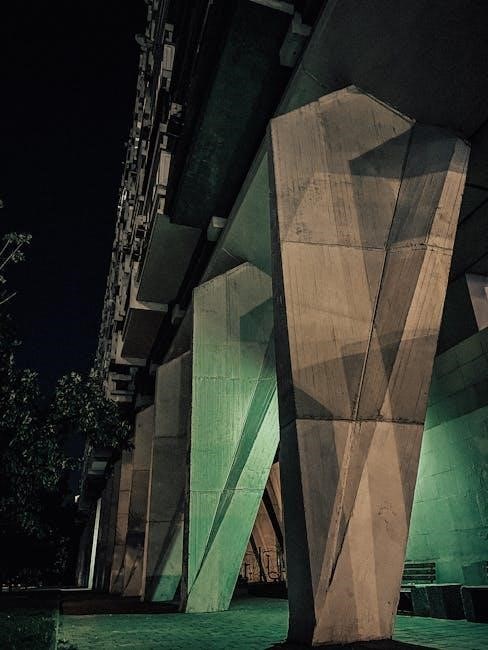Concrete blocks are a fundamental building material, widely used in construction for walls, foundations, and structures due to their durability, strength, and versatility in various applications;

1.1 Overview of Concrete Blocks
Concrete blocks are precast concrete masonry units manufactured from a mixture of cement, aggregate, and water. They are widely used in construction for building walls, foundations, and other structures due to their durability, strength, and versatility. Available in various sizes and types, such as solid, hollow, and lightweight blocks, they offer flexibility for different applications. Their uniformity and ease of installation make them a popular choice in both residential and commercial construction projects.
1.2 Importance in Construction
Concrete blocks are a cornerstone in modern construction due to their versatility, strength, and durability. They provide excellent load-bearing capacity, thermal insulation, and fire resistance, making them ideal for both residential and commercial projects. Their uniform size and ease of installation streamline construction processes, reducing costs and time. Additionally, concrete blocks contribute to energy efficiency and sustainability, aligning with green building practices. Their widespread use underscores their critical role in creating durable, safe, and environmentally friendly structures.

Types of Concrete Blocks
Concrete blocks are categorized into solid, hollow, lightweight, and specialty types, each offering unique properties and applications in construction, ensuring versatility for various building needs.
2.1 Solid Concrete Blocks
Solid concrete blocks are dense, non-hollow units made from a mix of cement, sand, and aggregate. They are highly durable and ideal for load-bearing walls, offering superior strength and structural integrity. Their dense composition minimizes moisture penetration, making them suitable for exterior and foundation constructions. Solid blocks are widely used in commercial and residential projects where stability and longevity are prioritized. They provide excellent thermal mass and acoustic performance, enhancing overall building efficiency and comfort.
2.2 Hollow Concrete Blocks
Hollow concrete blocks contain one or more voids to reduce weight and improve insulation. They are ideal for non-load-bearing walls and partitions, offering thermal efficiency and easier handling. These blocks are often reinforced with steel for added strength. Hollow blocks are cost-effective and versatile, suitable for various construction projects. Their voids can be filled with concrete and rebar for enhanced structural integrity, making them a practical choice for modern building techniques. They are widely used in residential and commercial constructions for their balance of durability and lightweight properties.
2.3 Lightweight Concrete Blocks
Lightweight concrete blocks are made using materials like expanded clay, shale, or aerated concrete, reducing their density. They provide excellent thermal insulation, lowering energy costs, and are easier to handle due to their reduced weight. These blocks are ideal for interior partitions and exterior walls, enhancing energy efficiency in buildings. Their lightweight nature also allows for faster construction without compromising structural integrity. They are a popular choice in sustainable and eco-friendly construction projects, offering both durability and environmental benefits.
2.4 Specialty Concrete Blocks
Specialty concrete blocks are designed for unique applications, offering enhanced functionality and aesthetics. These include decorative blocks for architectural finishes, soundproofing blocks for acoustic insulation, and fire-resistant blocks for safety. Others, like pre-stressed blocks, provide structural advantages. Specialty blocks are tailored to meet specific project requirements, combining durability with specialized features. They are ideal for complex designs, offering versatility and performance in various construction scenarios, from decorative facades to high-performance buildings.

Materials and Manufacturing Process
Concrete blocks are made from cement, sand, aggregates, and water, mixed in specific ratios. The manufacturing process involves mixing, molding, vibration, and curing to ensure durability and strength.
3.1 Raw Materials Used
The primary raw materials for concrete blocks include cement, sand, aggregates (such as gravel or crushed stone), and water. The mix design varies depending on the intended use, with ratios typically ranging from 1:6 for cement to aggregate. Additionally, additives or special materials like fly ash may be incorporated to enhance properties. The quality and proportion of these materials significantly influence the strength, durability, and weight of the final product, making them critical in the manufacturing process.
3.2 Manufacturing Techniques
Concrete blocks are manufactured using a combination of mixing, molding, and curing processes. The raw materials are mixed to achieve the desired consistency, then poured into steel molds. Vibration machines are often used to eliminate air pockets, ensuring density and uniformity. The blocks are pressed using hydraulic machines for precise shaping. After molding, they are cured under controlled conditions to enhance strength. Finally, the blocks are finished, inspected for quality, and prepared for distribution. This process ensures durability and consistency in the final product.

Technical Specifications and Classifications
Concrete blocks are classified by weight, with lightweight, medium, and dense options. They must meet specific dimensional tolerances and strength requirements, ensuring structural integrity and durability in construction applications.
4.1 Dimensions and Tolerances
Concrete blocks are manufactured in standard dimensions to ensure uniformity and ease of construction. Typical block sizes range from 100mm to 300mm in height, 100mm to 200mm in width, and 300mm to 600mm in length. Tolerances are critical to ensure proper fitting and structural integrity. Blocks must adhere to specified dimensional variations, usually within ±3mm to ±5mm, depending on the manufacturer and application. These standards ensure compatibility and minimize gaps during installation, contributing to the overall durability and performance of concrete block structures.
4.2 Strength and Durability
Concrete blocks exhibit high compressive strength, ranging from 3 to 40 MPa, depending on the type and manufacturing process. Solid blocks are denser, offering greater load-bearing capacity, while hollow blocks provide structural efficiency with reduced material use. Durability is enhanced by their resistance to weathering, fire, and pests. Proper curing and high-quality materials ensure long-lasting performance, making them suitable for harsh environmental conditions. Regular testing and compliance with standards further guarantee their reliability in construction projects.

Applications in Construction
Concrete blocks are widely used in both residential and commercial construction for building walls, foundations, and structural components, offering versatility and durability in various construction projects.
5.1 Residential Construction
Concrete blocks are extensively used in residential construction for building exterior walls, interior partitions, and foundations due to their strength, durability, and thermal insulation properties. They provide excellent load-bearing capacity, making them ideal for multi-story homes. Their ability to reduce noise and energy consumption adds to their popularity. Additionally, concrete blocks offer design flexibility, allowing for various finishes and textures, making them a versatile choice for modern residential projects. Their durability ensures long-lasting structures with minimal maintenance needs.
5.2 Commercial Construction
Concrete blocks are widely used in commercial construction for their strength, durability, and cost-effectiveness. They are ideal for structural frameworks, walls, and partitions in offices, retail spaces, and industrial buildings. Their high load-bearing capacity and fire resistance make them suitable for large-scale projects. Additionally, concrete blocks provide excellent thermal insulation, reducing energy costs and enhancing sustainability. Their versatility allows for various finishes, making them a popular choice for modern commercial designs. This makes them a reliable and efficient option for constructing durable and functional commercial spaces.

Fire Resistance and Safety
Concrete blocks offer excellent fire resistance, meeting international fire rating standards. Their dense structure provides superior thermal insulation, ensuring safety in high-temperature conditions and preventing fire spread.
6.1 Fire Rating Standards
Concrete blocks are evaluated based on fire rating standards, which determine their resistance to fire. According to the International Building Code, their fire resistance is calculated using equivalent thickness and aggregate type. Hollow and solid blocks have different ratings, with dense blocks typically offering higher resistance. These standards ensure that concrete masonry units meet safety requirements in various construction projects, providing reliable fire protection for buildings.
6.2 Thermal Performance
Concrete blocks exhibit varying thermal performance based on type and design. Hollow blocks can enhance insulation when voids are filled with insulating materials, while solid blocks provide thermal mass, regulating interior temperatures. Lightweight and aircrete blocks, with their lower density, offer improved thermal insulation. These properties contribute to energy efficiency in buildings by reducing heat transfer and maintaining consistent indoor climates, making concrete blocks a versatile choice for thermally efficient construction projects.

Sustainability and Environmental Impact
Installation and Maintenance
Proper installation requires precise alignment and appropriate mortar to ensure structural integrity. Regular maintenance involves cleaning and inspecting for cracks to maintain durability and appearance.
7.1 Eco-Friendly Manufacturing
Eco-friendly manufacturing of concrete blocks focuses on reducing environmental impact by using recycled materials like fly ash and slag. These materials lower cement consumption, decreasing CO2 emissions. Advanced techniques, such as autoclaving, improve energy efficiency and reduce waste. Lightweight blocks made from aerated concrete also minimize resource use. Many manufacturers adopt sustainable practices, ensuring products meet environmental standards while maintaining strength and durability. This approach aligns with global sustainability goals, making concrete blocks a greener choice for modern construction.
7.2 Energy Efficiency in Buildings
Concrete blocks enhance energy efficiency by providing excellent thermal insulation, reducing heat transfer, and minimizing heating and cooling demands. Lightweight and hollow blocks are particularly effective, as they contain air voids that act as natural insulators. This reduces energy consumption and operational costs. Additionally, their high thermal mass helps regulate internal temperatures, contributing to passive building design. By improving energy performance, concrete blocks support sustainable and energy-efficient construction, aligning with modern building codes and environmental goals.
Proper installation involves leveling surfaces, applying mortar, and aligning blocks precisely. Regular maintenance includes sealing gaps and cleaning surfaces to ensure longevity and structural integrity.
8.1 Best Practices for Installation
Ensure the surface is level and clean before laying blocks. Use a spirit level to align blocks accurately, applying mortar evenly between joints. Properly fill gaps and joints to avoid structural weakness. For hollow blocks, fill voids with concrete if required for added strength. Allow mortar to set completely before applying finishes. Regularly clean tools and blocks to prevent contamination. Follow manufacturer guidelines for block placement and spacing to achieve optimal results and durability in construction projects.
8.2 Maintenance Tips
Regularly inspect concrete blocks for cracks or damage and address issues promptly. Clean surfaces with water or mild detergents to prevent dirt buildup. Seal blocks to protect against moisture and stains. Avoid using harsh chemicals that may damage the material. Repair cracks with appropriate fillers to maintain structural integrity. Protect blocks from prolonged exposure to extreme weather conditions. Schedule periodic inspections to ensure long-term durability and performance of the concrete block structure.
Future Trends and Innovations
Innovations in concrete blocks include high-strength mixes, lightweight materials, and sustainable manufacturing. Advances in 3D printing and automated production are expected to enhance efficiency and customization in construction.
9.1 Advances in Materials
Recent advancements in concrete block materials include the use of high-strength concrete, polymer concrete, and recycled materials like fly ash. These innovations enhance durability, reduce environmental impact, and improve thermal performance. Lightweight materials, such as autoclaved aerated concrete, are gaining popularity for energy-efficient buildings. Additionally, researchers are exploring self-healing concrete and advanced aggregates to improve strength and sustainability. These material advancements are transforming the construction industry by offering more versatile and eco-friendly concrete block solutions.
9.2 Innovative Applications
Concrete blocks are being used innovatively in modern architectural designs, such as energy-efficient buildings, high-rise structures, and decorative facades. Advances in 3D printing technology allow for custom-shaped blocks, enabling complex designs. Insulated concrete blocks are now widely used for thermal performance in green buildings. Additionally, lightweight blocks are being integrated into acoustic panels, enhancing soundproofing. These innovative applications are expanding the role of concrete blocks in sustainable and functional construction, pushing the boundaries of traditional masonry techniques.

Concrete blocks are a versatile and essential construction material, offering durability and strength for various applications. Their adaptability in residential and commercial projects, combined with advancements in eco-friendly manufacturing, makes them a sustainable choice. With continuous innovations in materials and techniques, concrete blocks remain a cornerstone of modern building, providing cost-effective and reliable solutions for future construction needs.